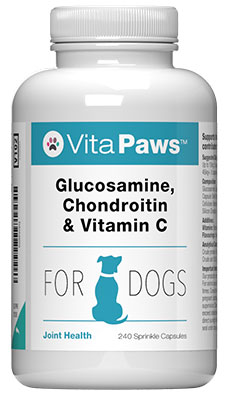Glucosamine for Dogs

Glucosamine is one of the most popular joint supplements in the world, which has been shown to be both safe and effective for thousands of people. In recent years, however, a growing number of pet owners have also started to offer glucosamine to their dogs to help with joint issues.
Let’s take a close look at exactly what glucosamine is, what the science tells us about glucosamine for dogs, and its effects on joint problems like arthritis...
What is Glucosamine?
Glucosamine is a crystalline substance classified by chemists as an “amine sugar”. What matters for arthritis sufferers, however, is that glucosamine is an important structural element in the joints. While glucosamine is a naturally-occurring substance, and is commonly produced by the body, a range of factors can result in these levels dropping. When this occurs, joint issues can arise.
Glucosamine comes from a range of sources, though most commonly it is extracted from marine crustaceans. In supplement form it is typically found either as a powder, or is condensed into tablets or capsules. Studies have shown that consuming glucosamine supplements helps to boost the level of this important nutrient in the body, as it is well-absorbed through the gut when properly prepared.
What is Arthritis?
Arthritis is so common in people that most of us have at least a passing understanding that arthritis describes the gradual degeneration of joints, leading to reduced mobility and pain.
To understand how arthritis arises, however, let’s dig a little deeper for a moment. The ends of bones are normally covered in a tough layer of cartilage. This cartilage helps to protect the bones where they meet at a joint, preventing the bones themselves from rubbing against one another.
Sadly, cartilage can start to break down over time, or may become less pliable. Under such circumstances, with the protective cartilage wearing thin, the bones may come into contact with one another. This is what causes pain, swelling and reduced mobility - the symptoms we know as osteoarthritis.
In people, while sports injuries and medical conditions can lead to arthritis at a young age, it is generally a condition confined to older people. In dogs, however, you might be surprised that the onset of arthritis isn’t always linked to age. Indeed, several studies have suggested that roughly 20% of all dogs over the age of one are affected. Some experts even believe that joint degeneration in dogs is commonly derived from “congenital or acquired deformation of joints” rather than simply as a result of old age.
Of course, large and giant breed dogs like St. Bernard’s, Leonbergers and Great Danes also tend to be at greater risk of joint problems due to the additional weight they carry around.
The key message here is that even small breeds of dog can suffer from joint problems - and many develop arthritis much earlier in life than you might otherwise realize.
Fortunately, glucosamine is a popular, safe and reasonably-priced treatment which many pet owners swear by.
The Benefits of Glucosamine for Dogs
Glucosamine has long been a popular joint supplement among people, but glucosamine for dogs is a rather new topic. This means that studies on the effects of glucosamine in dogs are far fewer than those addressing the effects in people.
All the same, in this section we’ll piece together some of the most important veterinary research to assess what impact glucosamine has on joints.
One particular study split a group of arthritic dogs into two groups; the first of which received a traditional painkiller while the other group received a supplement containing glucosamine and chondroitin.
Vets, who were not told which treatment each dog was receiving, were asked to assess the extent of discomfort experienced by each dog regularly over a period of 70 days. Reassuringly, the experts observed positive results from the supplement, reporting that dogs treated with glucosamine and chondroitin “showed statistically significant improvements in scores for pain, weight-bearing and severity of the condition”.
Another study provided dogs suffering from osteoarthritis (OA) with either 10mg of glucosamine per kilogram of body weight or a placebo. Over the next four weeks blood samples were drawn in order to assess the extent of inflammation in the joints, looking for specific enzymes known to be closely linked to arthritis. The results showed that these blood markers were “significantly lower” in the glucosamine group, with the scientists concluding that “oral glucosamine...modified the progression of OA”.
Lastly, it is interesting to discuss the topic of hyaluronic acid; a lubricating fluid found within the joints. Studies indicate that in cases of arthritis the level of hyaluronic acid tends to decline. Think of it rather like your car running out of oil - motion can become harder and more damaging.
At the same time it has been suggested that supplementing with additional hyaluronic acid may be beneficial for replenishing these levels. Indeed, one group of scientists investigating the topic claimed that hyaluronic acid “may function physiologically to aid preservation of cartilage structure and prevent arthritic pain”.
Human studies have taken this theory to heart, and researchers have found that injecting hyaluronic acid directly into affected joints can lead to improvements in joint pain and range of motion. This is all well and good, but giving your dog regular injections in sore joints probably isn’t the most appealing idea for dog or owner alike.
Fortunately, there is evidence to suggest that glucosamine itself stimulates the production of additional hyaluronic acid. As one investigation reported “glucosamine therapy for osteoarthritis can be expected to increase hyaluronic acid production” in the joints. While this has yet to be tested in the laboratory it has been predicted that “high-dose glucosamine may provide rapid symptomatic benefit, and in the longer term aid the repair of damaged cartilage” thanks to its effect on hyaluronic acid.
In all, while the research is still in its early days, there is growing scientific evidence to back up what numerous dog owners around the world have found - quite simply that glucosamine (and chondroitin) seem to offer significant benefits for joint pain and trouble moving.
Glucosamine for Diabetic Dogs
Glucosamine is classed as a type of sugar, so understandably concerns have been raised in the past when it comes to diabetes. Does taking a glucosamine supplement negatively impact blood sugar control in people or dogs?
Our trusty nutritionists have managed to dig up a research paper that investigated the issue of glucosamine and blood sugar in dogs specifically. “Fructosamine” is a compound typically found in the blood, and is a byproduct of sugar in the blood. In contrast to measuring blood glucose itself, which is simply a snapshot of current levels, fructosamine levels indicate blood sugar levels over the last few weeks. As a result, it gives a clearer picture of blood sugar over a longer period of time and is considered the gold standard of measurement for diabetic investigations.
In a study, 12 dogs were given a supplement containing glucosamine and chondroitin for a four week period during which fructosamine levels in the blood were recorded. The results showed no significant change between the glucosamine group and the dogs receiving an inert placebo. The scientists running the experiment therefore concluded that glucosamine “does not affect glycemic control or cause diabetes mellitus”.
While this research is very positive, it is important to point out that the number of participants was small, and that diabetic dogs can require extra special care. We would therefore always advise you to seek professional advice from your vet before giving any supplement to your diabetic pet.
Choosing the Right Glucosamine Supplement
There are a huge number of different glucosamine supplements for dogs, and they vary in a dizzying number of ways. So how do you choose the best glucosamine supplement for your needs?
Glucosamine Sulphate Vs Glucosamine Hydrochloride
Most glucosamine found in supplements comes in one of two forms: glucosamine sulphate or glucosamine hydrochloride. But which is best?
Researchers looking to answer this very question noted that most popular glucosamine supplements for dogs use glucosamine hydrochloride (HCl), despite the fact that it is “known to have poorer bioavailability”. They argued that the reason for its prevalence in so many supplements is that it is “cheaper to produce” and that many pet owners don’t know any different.
The first step, therefore, is to consider supplements that contain glucosamine sulphate rather than hydrochloride. While they might cost slightly more, the research suggests that your pet should be able to absorb far more of each capsule than an identical dose of glucosamine hydrochloride.
Delivery Mechanism
One difficulty with giving any kind of supplement to dogs is that they can be so fussy. While the odd canine may willingly swallow tablets it is often necessary to get sneaky. Tablets or capsules can be hidden in wet food, for example, in the hope that your dog will swallow them without noticing. Sadly, all too often dogs are far cleverer than we give them credit, and many pets will reject the glucosamine while dusting off all the food offered.
Powdered glucosamine can be a great way to get around this issue. Under such circumstances the glucosamine powder can be sprinkled onto your dog’s food or added to their water bowl for easy consumption.
This is why we supply our glucosamine for dogs in “sprinkle capsules” that offer the best of all worlds. If your dog will swallow capsules or tablets then you’re all set. If not, you can easily open the capsule and sprinkle the contents onto food. No matter how fussy your pet is you’ll be able to ensure that they get a beneficial dose of glucosamine each day.
Differences between Human & Animal Glucosamine
A common question when it comes to glucosamine for dogs is whether you can simply give your pet glucosamine sold for people - after all what is really the difference? In reality the glucosamine sold for human consumption is essentially the same as is sold for pets, with a few important caveats.
Firstly, glucosamine for human consumption is often prepared to higher standards than that which is intended for dogs. Here at VitaPaws all of our supplements are produced using the same manufacturing process, so our glucosamine for dogs receives the same level of care and quality control as our capsules and tablets for human customers.
Secondly, many glucosamine supplements include a range of other ingredients; all designed to further help reduce inflammation and discomfort. While there is nothing wrong with this at all, if you’re planning to feed a human joint supplement to your dog you’ll want to be certain that all the ingredients are as safe for your pet as they are for you.
This is why we sell a dedicated glucosamine supplement for dogs, as you can feel confident that every last ingredient in our premium formulation has been checked for safety by our animal nutritionists. Indeed, our most popular glucosamine supplement includes just chondroitin and vitamin C - both safe for pets and thought to have beneficial impacts on the joints.
Lastly, of course, if you opt to feed human glucosamine to your dog you’ll want to ensure that the dosage is suitable for your pet. Every supplement in our VitaPaws pet range has been designed in conjunction with qualified animal nutritionists to give your dog the ideal dose every time.
How to Give Your Dog Glucosamine
A scientific study gave dogs both glucosamine and chondroitin supplements while monitoring the amount that was absorbed into the body from the gut. They found that roughly 5% of the chondroitin given and 12% of the glucosamine was absorbed after a single dose.
At the same time, they observed that as the body retains much of the glucosamine and chondroitin consumed, the volume available to the body increases with ongoing treatment. This underlines that your dog is unlikely to feel the full effects of supplementation initially, and that it is important to continue this treatment over the long term.
Another study compared the impact of glucosamine when compared to carprofen - a painkiller often prescribed by vets for arthritis and other joint issues. The experts reported that both treatments had a positive effect, but the onset of positive results took longer with glucosamine.
Some studies in humans have suggested that the impact of glucosamine can continue to increase for 12 weeks or even longer; therefore aim to supplement your pet for some months before making a final decision about whether they are actually benefiting.
Conclusion
Nobody wants to see their dog suffer unnecessarily from joint discomfort, irrespective of their age. While veterinary guidance should always be sought for such conditions, the scientific evidence suggests that glucosamine for dogs can also be beneficial.

 Richard
Richard 
























